Which Services Save Money on Transactions in Tron? Top Solutions
The question posed in the title is often asked by newcomers to the Tron blockchain. In principle, the term "money" can refer to all assets and resources related to this ecosystem. All of them can be converted to the rate of any fiat currency. But let's focus on the main assets that are most often associated with paying for gas during transactions – the native currency of the eco-platform TRX and the stablecoin USDT.
USDT TRС-20 is a version of the Tether (USDT) stablecoin issued specifically for Tron. It is transfers of this token, pegged to the US dollar rate, that account for the lion's share of transactions on the Tron ecosystem network.
So, the question in the title can be refined. We explain how special services can help you save your TRX and USDT and avoid burning them on transaction fees. Specific knowledge about Tron technologies will help here.
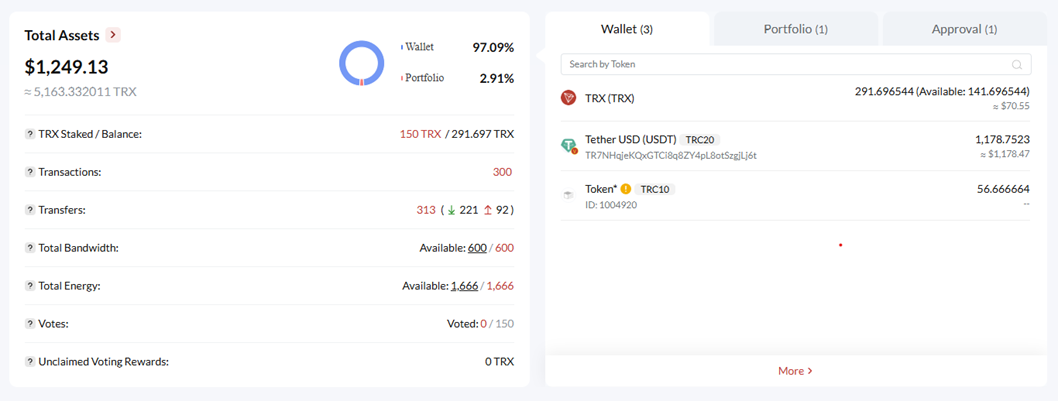
What Can You Pay for Gas with in Tron
During transactions on the blockchain, a different set of assets and resources can be used to pay for gas:
- native TRX crypto tokens;
- special resources Energy and Bandwidth;
- recently – USDT stablecoins.
Active users who frequently transfer Tron stablecoins, developers of smart contracts (various decentralized applications, for example), in short, everyone who interacts with TRC-20 standard tokens, of course, prefer to use the special resources Energy and Bandwidth to pay commissions.
Otherwise, they would have to spend significant amounts in TRX, as is customary on most other cryptocurrency blockchains, where transactions are paid only in the native crypto or their own version of stablecoins.
However, for many blockchain newcomers, it becomes a revelation that it is not necessary to spend hard-earned TRX or USDT on transactions in Tron. Furthermore, many find obtaining the most important resource – Energy – complicated.
Why does Energy specifically cause difficulties? Because every user sees the daily replenishment of Bandwidth in their wallet – Tron distributes 600 units of this resource to everyone, which the participant then uses to pay for the network's expenses on improving throughput specifically for their transaction.
Those interacting with smart contracts should know that each transaction will take a certain amount of Bandwidth from your wallet. For example, one USDT TRC-20 transfer (which is also a smart contract, like all TRC-20 tokens) will require 345 units of Bandwidth. That is, the daily free limit is not enough even for a couple of transfers per day. What happens when the Bandwidth reserve runs out during a transaction? The transaction does not stop if there is TRX in the account – the system will start burning your native crypto tokens without any warning.
The same happens if you don't have enough Energy. Only in this case, the loss of TRX will become more critical and noticeable. It is then that inexperienced users wonder: why did both resources and TRX disappear after the transaction? Simply, the user did not account for the upcoming Energy consumption, or the state of the overheated network, or the conditions of the exchange to which USDT was transferred.
Rest assured, this is not the worst scenario. It is much worse when a transaction hangs due to insufficient funds for the gas fee. Actions in the decentralized blockchain model are irreversible. Once a transaction is added to a block, it can neither be deleted nor changed. That is, the user loses their funds irrevocably.
To prevent this from happening – diligently study the possibilities provided by Tron if you plan to quickly transition from a beginner to an active user and developer of smart contracts.
Ways to Obtain Energy: Staking or Renting?
This is one of the most important resources on the Tron network for paying gas fees during transactions related to TRC-20 standard tokens. For example, for one USDT TRC-20 transfer, you will need 65,000 or 131,000 units of Energy (corresponding to 13.5 and 27 TRX) to pay the commission.
By the way, you should always check the recipient's balance. If they already have these stablecoins, you will pay the first amount for gas; if not – the second. This is a requirement of Tether (USDT), not the Tron blockchain.

To get enough Energy for even a couple of transfers, you need to stake almost 24,000 TRX. Any online calculator will convert the value of this asset into USD – and you will be surprised by the result.

Yes, you must withdraw these funds from circulation to get Energy for just a couple of USDT TRC-20 transfers. Firstly, you will have to wait half a month for this amount to return to circulation; secondly, not everyone has that much TRX on their balance.
Here, alas, more pain can be added: it's not guaranteed that you will receive the expected volume of Energy. After all, the size of the reward for frozen assets depends on the total volume of TRX being staked across the entire network at that moment. That is, the following scenario is possible: you start staking, having accurately calculated the volume of TRX, yes, you immediately receive Energy, BUT in a smaller volume than you expected. What to do? Add another portion of TRX to staking or simply allow the system to burn them during the transaction after the received Energy is gone from the account?
What remains for those who constantly need Energy for transferring Tron stablecoins or developing decentralized applications, indeed, for any interaction with smart contracts? After all, they are the majority in the Tron system.
Until recently, they had to resort to inconvenient staking, accumulating the necessary volumes of TRX or burning native crypto in transactions. Before the advent of Energy rental services, there were no other options.
1. Energy Renting Services
Now it is not necessary to own a large volume of native crypto to obtain practically any required volume of Energy. Here too, several paths can be taken. You can independently search for and rent resources from other users with large staking positions who are willing to provide you with staked Energy for a small fee for a certain period.
But for most users, this is a very difficult path, and practically impossible for beginners, as it requires knowledge of the market for special resources of the Tron ecosystem.
How Not to Make a Mistake When Choosing an Energy Rental Service
It is much simpler and faster to act through Energy rental services, which have begun to be actively built and developed based on the blockchain. By renting Energy, you can forget about the lack of resources during transactions.

Let's consider important factors when choosing such a service.
Maximum possible savings on transactions. Be sure to conduct a test – rent a small amount of Energy first to find out if the service's advertising promises match reality. Quality services usually welcome this approach and offer a "trial" themselves. You should be able to check the real percentage of savings per transaction. It often happens that, while claiming large savings on transaction costs, the service omits some additional commissions or provides a smaller volume of Energy than stated.
Presence of a Telegram bot or other automation. Services without proper automation cannot provide the user with a refund for unused but prepaid Energy. The same applies to situations where the transaction was not carried out within a certain period. Of course, the resource will not disappear in this case either, but the fact remains: the presence of a Telegram bot or automation via a web interface with the possibility of opening a deposit provides the user with more opportunities, including in managing Tron resources.
Flexible structure and user-friendly interface. If the process of interacting with a service that offers Tron resources for rent is not intuitively clear and simple, it means the service was initially tailored for other tasks. As a rule, Energy rental is of secondary importance for such a platform. This affects the search for pools and the most advantageous resource providers, orientation in the conditions of this particular market. This means the service offers less favorable rental conditions.
We recommend several Energy rental services that offer users the most advantageous conditions.
Netts.io
Website address: https://netts.io
Telegram bot address: https://t.me/netts_energy_order_bot
This Energy rental service has not only a form on the site through which you can place an order for Energy rental by prepayment. The Telegram bot allows you to open a deposit for 15 TRX. The automation web interface with a minimum deposit of only 1 TRX and a personal client cabinet, Workspace, provides different levels of automation adapted to your regime:
- using a trigger;
- applying a specific balance charging schedule;
- with instant balance replenishment after using the previous volume of Energy, etc.
Testing showed that the cost of obtaining 131K Energy for an hour to transfer USDT TRC-20 to an "empty" wallet costs about 5.7 TRX and even around 5 TRX at night. So the stablecoin transfer transaction itself is free: you pay the gas fee with Energy rented from NETTS. And the service will take the above-mentioned fee from the deposit only for its services and your comfort.
You can see the percentage of savings from the calculation display on the screenshot. Remember that 131K Energy is equivalent to 27 TRX and calculate the savings. About 80%! This is a record in the Energy rental market.
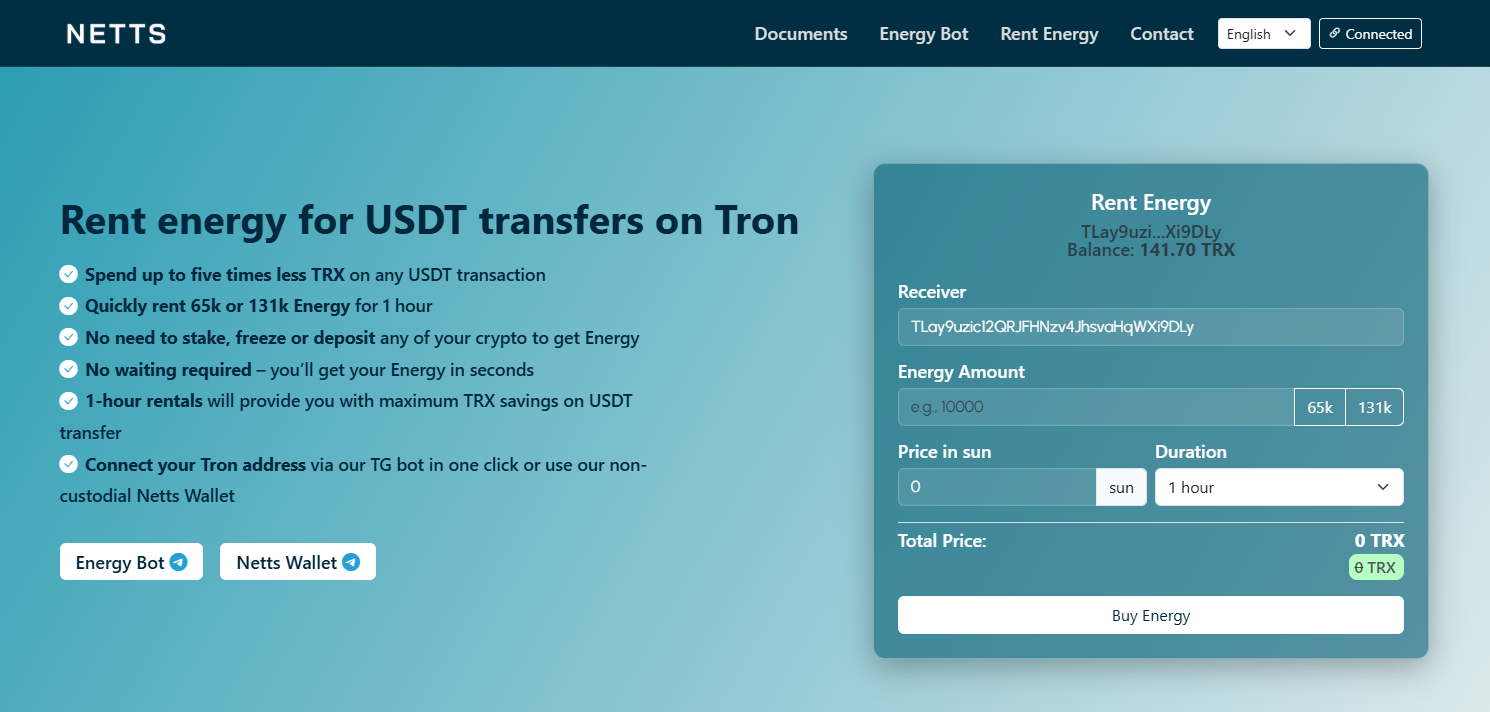
But if during the transaction it turns out that the recipient's wallet has USDT on balance, only half of the TRX indicated in the calculation will be deducted from your deposit. And if for some reason you refuse the transfer within the agreed time (1 hour in our case), nothing will be charged for the volume of Energy you ordered, and the service will simply return the resource from your wallet.
The NETTS service continues to develop, and currently, you can order a service such as automatic balance replenishment when it drops to a certain volume.
For those who regularly and frequently interact with any types of smart contracts, this is a very valuable function that eliminates transaction freezes and irreversible loss of funds.
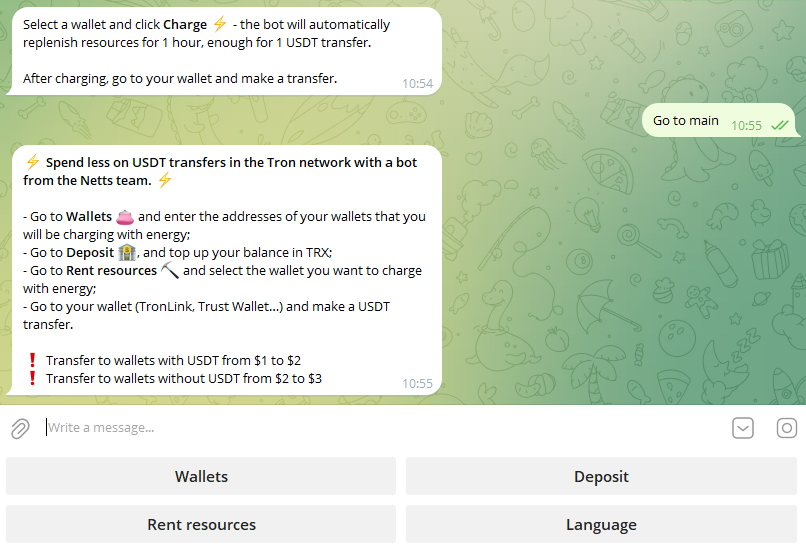
At the same time, you can also rent Energy through the site, but with prepayment and the impossibility of returning the unused volume.
Very easy to master – the interface is simple, user actions are constantly accompanied by hints.
Feee.io
The Feee.io platform has its own Telegram bot - @feee_io_bot
However, the platform is not fully focused on Energy rental, as it was initially built for exchange trading of resources. Therefore, there is also an exchanger providing the exchange rate upon request, as well as the ability to monitor transactions.
Energy rental offers are calculated more for large Tron traders, who are provided with an additional reduction in service fees.
But the screenshot of renting only 32,000 units of Energy indicates that for "retail" renters, the savings on commissions differ somewhat from those stated.

Tronify.io
Tronify is a convenient platform for buying, selling, and renting energy, also providing staking services. It has its own API for automation.
Not all Energy rental services have convenient and advantageous automation, thanks to which rental services can be obtained without much hassle and interface разбирательств. The Telegram bot (@tronify_energy_bot) of this service provides Energy and virtual currency rental services.
However, there are discrepancies in the stated savings when transacting with Energy rented here. Here is what we see in the screenshot:
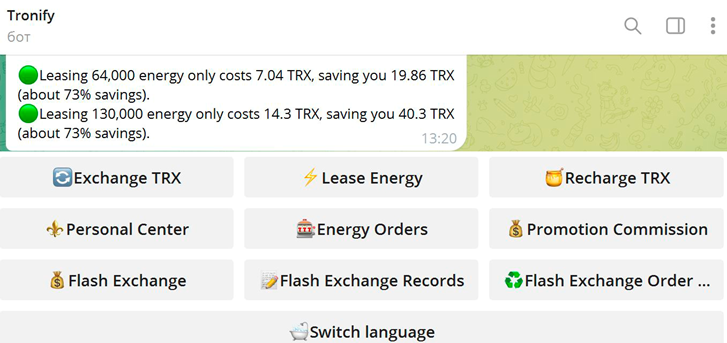
And we are slightly perplexed when we recall where the figures of 27 TRX for 64K Energy came from, given the usual commission of 13.65 TRX? And what about the 54 TRX for 131K, from which the alleged 73% savings are calculated? Of course, this will all be cheaper than staking in the end, but be careful with such claims about savings – not all services are equally advantageous.
Other Energy Rental Services
Of course, the list of platforms based on Tron can be continued – the most advantageous and popular ones were given above as examples.
Among other reliable platforms that also provide Energy rental services:
- TronSave;
- JustLend DAO;
- Tron Energy Market (TEM);
- Tron Pulse;
- Tron Energize.
It is best to check for yourself which service suits you best – visit each site, make test cheap orders, check the functionality of the Telegram bot, automation web interface, etc. Look for the best prices without unnecessary problems and failures: round-the-clock availability of the service is also an important factor.
2. Staking Services
Of course, staking is still a better option than burning TRX. And it is not surprising that platforms have appeared that offer TRX holders this function on more favorable terms, according to the services themselves, among which the most famous are:
TronWallet. A mobile wallet for the Tron network, with a user-friendly interface that offers various staking options, including voting for super representatives, participating in staking pools through its super representatives, as well as direct staking – for holders of large volumes of TRX (who most often are part of the super representatives).
Sesameseed. A decentralized community operating on the same principle but using SEED tokens as rewards. Higher payouts and bonuses are provided for experienced players (read – holders of the largest assets).
TronTrade. The principle of distributing rewards for staking on this decentralized exchange is the same. Only users receive rewards in TRXD tokens. There is a minimum limit: the minimum stake amount today is 100 TRX.
Cryptomus. This payment platform operates without charging commissions for its staking services, has a conveniently organized interface for tracking rewards, and provides users the ability to manage multiple wallets.
In short, all these services are an additional option for those Tron participants, as well as "external" TRX holders, who are set on receiving passive income without additional costs. But, as can be seen even from the brief descriptions, they are still designed for holders of large volumes of TRX and, moreover, compared to energy rental, the benefit is very small.
3. GasFree. Without Gas Fees – Even More Expensive
Since March 2025, another function has been added to the Tron blockchain. GasFree allows excluding both TRX and Tron resources from gas payments. The function is aimed at transferring USDT TRC-20. It is assumed that this will simplify the introduction of beginners to transactions in the Tron system, and relieve other users from staking and other methods of obtaining special Tron resources.
Of course, we are not talking about free transactions, as was enthusiastically perceived initially by everyone involved in USDT TRC-20 transfers. Simply, transactions using this function are also paid in Tron stablecoins. Moreover, initial tests show that this is much more expensive than using resources or TRX.
Here is a rather eloquent screenshot from testing the transfer of 8 USDT TRC-20 via GasFree with payment in the same tokens.
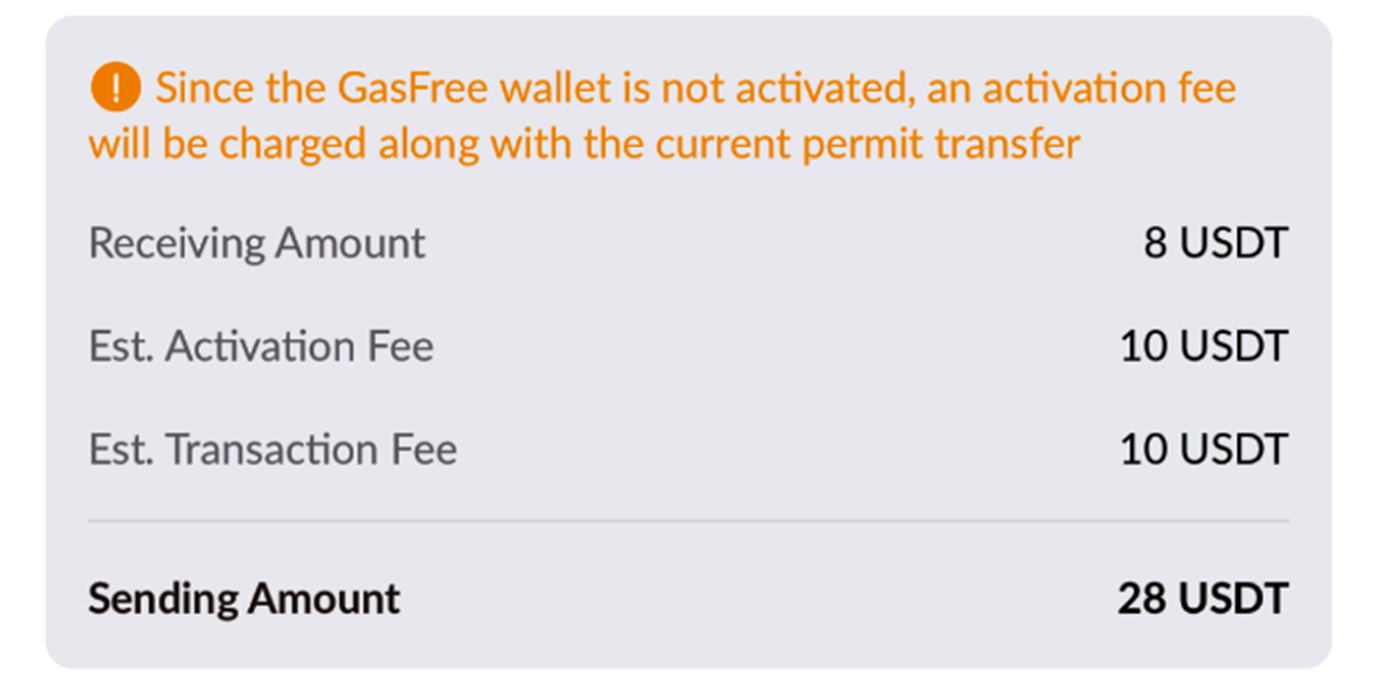
Let's not take into account the payment for activating the GasFree wallet (this is a mandatory condition for using the function), but the size of the transaction fee is also not pleasing.

Even if you pay with native crypto from your balance or with Energy obtained from sending TRX to staking, it will already be much more advantageous. Now compare this with the commission charged by any Energy rental service for a transaction – the difference is huge.
The conclusions from all the above are simple.
- The most necessary service for those who regularly and frequently interact with TRC-20 standard tokens is an Energy rental service.
- Energy rental services provide practically free transactions, charging a negligible commission for services.
- To ensure free transactions for yourself, choose a service through trial testing.
- The most effective and advantageous Energy rental service is one that allows saving as much money as possible per transaction and allows full automation of the wallet recharging process without extra hassle.
- GasFree is currently limited only to transferring Tron stablecoins and is designed either for blockchain beginners or holders of large assets who do not want to deal with paying gas fees in Tron resources. This method is not suitable for those who wish to save on transactions.
And one more thing - do not confuse the service's Telegram channel with the presence of a Telegram bot at the service (above). Having an informational channel on Telegram does not provide the user with any preferences regarding Energy rental.
That's all. We hope this information helps you save as much TRX as possible in the future.